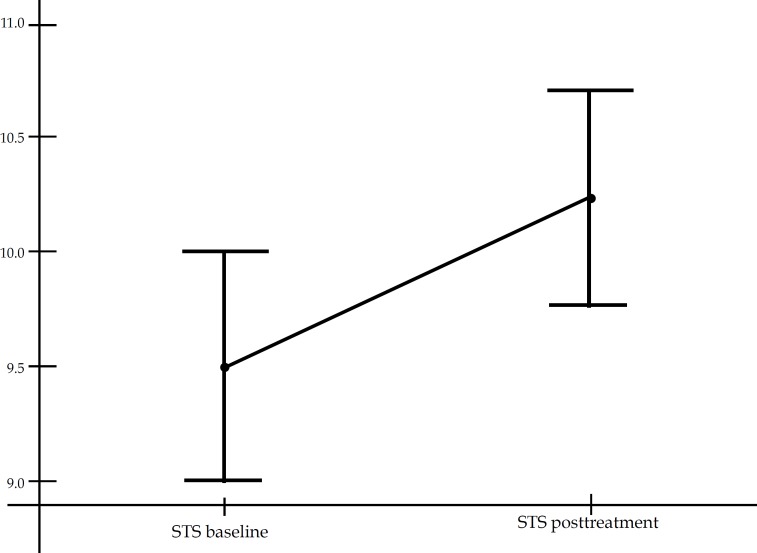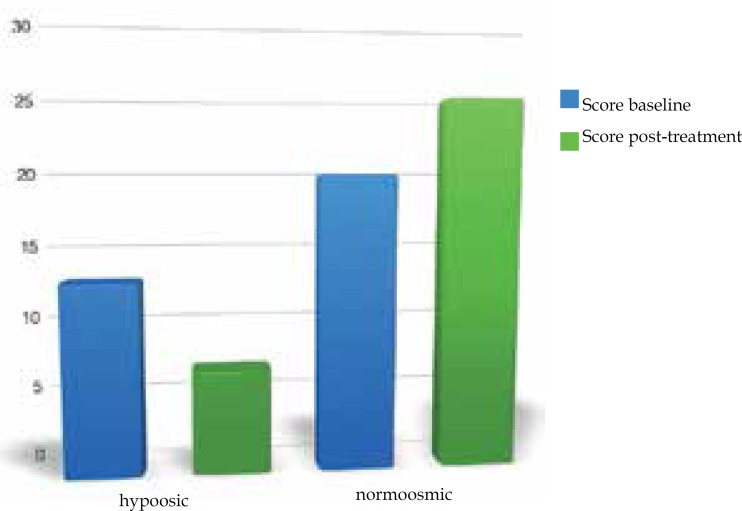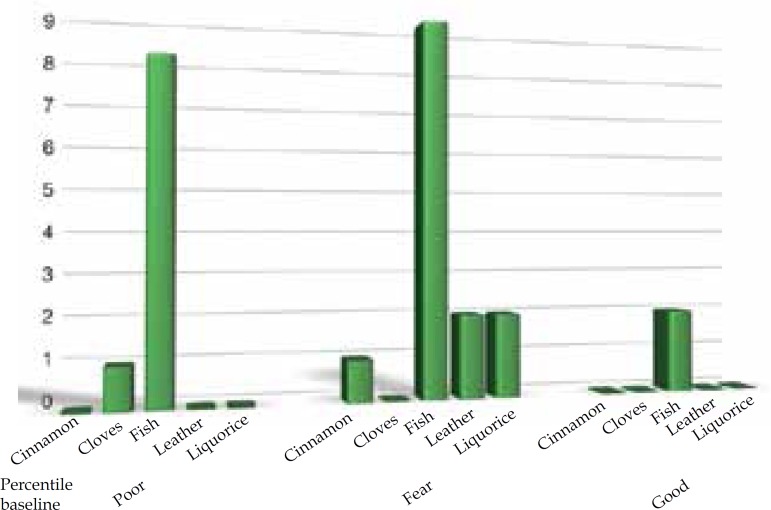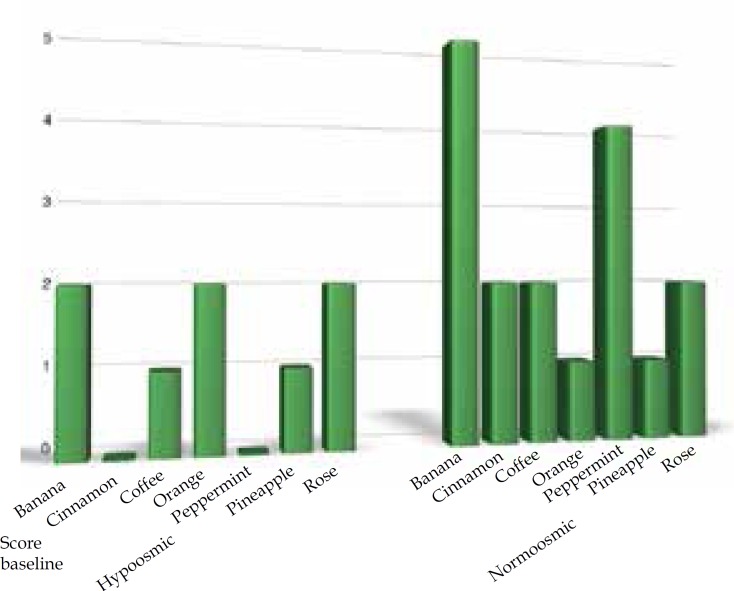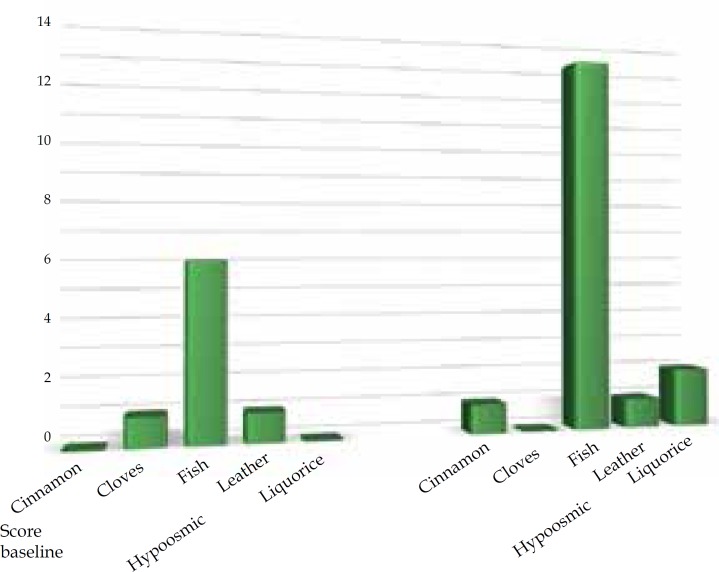Abstract
Background
Isotretinoin is a synthetic analog of vitamin A. Recent studies support a role for retinoic acid in the recovery of olfactory function following injury in mice.
Objective
This study aimed at determining the effect of isotretinoin on olfactory function in patients who have acne and are otherwise healthy.
Methods
Forty-five patients (aged 25-40 years) with acne were included in the study. All patients underwent a rhinological examination. Olfactory function was assessed by the Sniffin' Sticks Test. The test was assessed at baseline and in the third month of isotretinoin treatment.
Results
Isotretinoin improved the performance of patients in the olfactory test. The SST score increased from 8.7±1.09 to 9.5±1.19 (p<0.001), prevalence of hyposmia decreased from 40% to 24% and normosmia increased from 60% to 75% (p=0.059). The percentage of patients whose olfactory function was categorized as "good" increased from 6% to 21.3%. This increase was statistically significant (p<0.05).
Study limitations
Absence of a control group is one of the limitations of this study. Also, we did not evaluate patients with smell test after stopping isotretinoin treatment.
Conclusion
We examined the effect of systemic isotretinoin on olfactory function. It can be concluded from the present investigation that isotretinoin therapy improves the sense of smell.
Keywords: Isotretinoin, Olfaction disorders, Smell
INTRODUCTION
Olfaction plays important roles in the daily lives of patients, and a disturbance in olfaction is mostly experienced as a severe decrease in quality of life.1 Approximately 20% of the general population complains about an impaired sense of smell, and 5% of these people are anosmic.2,3
An olfactory disturbance can result in the inability to detect the odors of spoiled food, smoke, and leaking gas. Additionally, anosmic patients cannot detect the aroma and flavor of foods, thus problems in quality of life are essentially in the areas of safety and eating.4-7
Isotretinoin (13-cis retinoic acid) is a synthetic analog of vitamin A. It is indicated for systemic treatment of severe acne (such as nodular or conglobate acne) in patients resistant to standard courses of standard therapy with systemic antibacterials and topical therapy. Even though systemic retinoids are very effective medications, they have some adverse events. The most common adverse events are mucocutaneous (dryness, cheilitis, palmoplantar exfoliation, rash, and dermatitis), gastrointestinal (inflammatory bowel disease), and ocular problems (conjunctivitis and dry eye). 8
Retinoic acids (RA), including isotretinoin, can influence cellular growth, morphogenesis, differentiation, and apoptosis and malignant cell growth. They can inhibit tumor promotion, exert immuno-modulatory actions and alter cellular cohesiveness.9
Many studies about the different effects of RA have been reported. Some of these reports relate to the effects of RA on olfactory function. The results support a role for RA in the recovery of olfactory function following injury in mice.10,11 There has not been any previous clinical study about the effect of RA on olfactory function in humans treated with isotretinoin. Therefore, we aimed at determining the effect of isotretinoin on olfactory function in patients who have acne and are otherwise healthy.
METHOD
This study was a prospective study that was approved by the Ethics Committee of Erciyes University Medical School. From March 2014 to May 2015, 45 patients aged 18-40 years who had been identified as candidates for use of isotretinoin to treat acne were included in the study. All patients signed the written informed consent before enrolling in the study. Patients were recruited from those admitted to our dermatology outpatient clinic.
All patients underwent a rhinological examination at the ENT and Head & Neck Surgery Clinic of Kayseri Education and Research Hospital. Subjects with prominent septal deviation, allergic rhinitis, nasal polyposis or rhinosinusitis, diabetes mellitus, or neurological defects, were excluded. Subjects who were smokers or were receiving drugs that could affect olfaction, such as calcium channel blockers, ACE inhibitors, diuretics, statins or antidepressants were also excluded. In addition, subjects using any type of retinoid or vitamin A supplement or who had a recent history of psychiatric disorder were also excluded. Women with childbearing potential were only included if they were using at least two separate and effective methods of birth control and had a negative serum pregnancy test one week before the initiation of therapy.
Patients were instructed on the efficacy and adverse events of isotretinoin. The recommended dose of isotretinoin was 0.5-0.8 mg/kg per day. Laboratory tests included complete blood count, serum aspartate and alanine aminotransferase, total cholesterol, triglyceride, and high and low density lipoprotein were measured before treatment, one month thereafter and every two months thereafter until completion of the treatment.
Assessment of Olfactory Function
Olfactory function was assessed by the Sniffin' Sticks Test (SST) ("Sniffin' Sticks" Burghart GmbH, Wedel, Germany).12 Smell test sticks were used within six months of the production date in accordance with the manufacturer's instructions. The same operator applied smell identification tests in a well-ventilated room. This operator did not use powdered gloves or perfume. This test involves the presentation of odorants in felt-tip pens. The pens have a similar shape and color. The pen's tip is placed approximately 2 cm from both nostrils for 3 seconds with an interval of 30 seconds between the different pens. The Sniffin Sticks test battery includes the following 12 odors: leather, peppermint, banana, coffee, cinnamon, licorice, rose, fish, cloves, lemon, orange, and pineapple. After sniffing each odor, the patients were asked to find the right answer from a questionnaire including four options. All answers were recorded to obtain a score for both nostrils. All patients were asked which odor is most pleasant or unpleasant. The patients were classified as normosmia (10-12 scores), hyposmia (7-9 scores) and anosmia (0-6 scores) according to the right answers. In addition, patients were asked to rate their olfaction subjectively into one of three categories (good, fair, or poor). The Sniffin' Sticks Test was performed twice before starting the isotretinoin therapy and particularly in the third month of treatment.
All statistical analyses were performed using the IBM SPSS Statistics 22.0 package program (IBM Corp., Armonk, New York, USA). The Shapiro-Wilk test and Q-Q graphics were used to examine the normality of the data distribution. The Mann-Whitney U test was used for score comparisons according to gender groups. The Chi-square test's exact method was used for the pleasant and unpleasant odor comparisons according to gender groups. Significance was defined as p<0.05.
RESULTS
A total of 33 patients, 20 women and 13 men, completed the study. Twelve patients did not continue the treatment because of adverse events of the isotretinoin (dryness, cheilitis, conjunctivitis) or because they contracted an upper respiratory tract infection. The most common adverse event of isotretinoin was cheilitis. The mean age of the patients was 21.1±3.4 years. All blood counts and levels of liver enzymes and cholesterols were within normal ranges. The rhinological examination was normal in all patients. Regarding SST scores, 40% (n=13) patients were classified as hyposmic and 60% (n=20) were classified as normoosmic before treatment. No anosmic individual was recorded.
Mean SST scores were 8.7±1.09 before treatment and 9.5±1.19 after treatment. There was a statistically significant improvement (p<0.001) in SST scores between the before and after isotretinoin treatment values (Figure 1).
Figure 1.
The improvement of SST scores after the isotretinoin treatment. Mean SST scores were 8.7±1.09 before treatment and 9.5±1.19 after treatment
Olfactory function was classified as poor in 46%, fair in 48% and good in 6% of patients before treatment. After treatment, it was classified as poor in 30.3%, fair in 48.4% and good in 21.3% of subjects. Increase in olfactory function (approximately 30%) between all groups was statistically significant (p<0.05).
Prevalence of hyposmia and normosmia was 40% and 60%, respectively, before treatment and 24% and 75%, respectively, after treatment. Although there appeared to be an improvement after treatment, it did not reach statistical significance (p=0.059) (Figure 2).
Figure 2.
Increasing prevelance of normosmia and decreasing prevelance of hyposmia after the isotretinoin treatment. Y axis shows patients number
An assessment comparing each gender group revealed no significant difference in olfactory function in both the before and after treatment values (p>0.05).
Eight patients who could not recognize the odors did not answer the question about the most pleasant or unpleasant odors. In 25 patients, the bananas odor was selected as the most pleasant odor (28%), whereas the fish odor was selected as the most unpleasant odor in 76% of the patients. No significant difference was found between genders regarding the choice of the most pleasant and unpleasant odors (p>0.05).
An assessment based on the percentile baseline scores revealed that the most pleasant odors were banana, orange and rose in the group with poor olfactory function; banana in the group with fair olfactory function; and orange and peppermint in the group with good olfactory function (Figure 3). Fish was the most unpleasant odor in all groups (Figure 4). An assessment based on SST scores revealed that the most pleasant odors were banana, orange and rose in the hyposmic group and banana in the normoosmic group (Figure 5). Fish was the most unpleasant odor in all groups (Figure 6).
Figure 3.
The most pleasant odors for the percentile baseline scores
Figure 4.
The most unpleasant odors for the percentile baseline scores
Figure 5.
The most pleasant odors for the STS scores baseline
Figure 6.
The most unpleasant odors for the STS scores baseline
DISCUSSION
Retinoic acids, which are members of the steroid/thyroid hormone superfamily, can influence cellular growth, morphogenesis differentiation, and apoptosis and malignant cell growth. They can also inhibit tumor promotion, exert immuno-modulatory actions, and alter cellular cohesiveness. 9
In recent years, it has been shown that signaling via RA regulates olfactory neural stem cells throughout life. 13,14 Some RA-activated cells appear to be basal cells: they are situated directly apposed to the olfactory epithelium (OE) basement membrane, a position occupied by horizontal basal cells, the assumed adult OE neural stem cells. 15
It is well known that the ultimate effect of RA signaling in any cell is the repression or activation of gene expression. This effect appears to be caused by binding of an RA ligand with a broad range of heterodimeric receptor/transcription factors. 16 Several additional metabolic and transcriptional cofactors further modulate transcriptional activation via these receptors. RA coordinates the expression of many cytokines (i.e., leukemia inhibitory factor, macrophage colony stimulating factor and neurotrophins) and their receptors in numerous non-neuronal cells types (e.g., macrophages, oligodendrocytes, and astrocytes).17,18 The cytokines mentioned above are involved in neurogenesis and regeneration of the OE. 19,20
RA regulation of immune function may also assist cell maintenance, clearance or turnover in the olfactory pathway, especially in the OE, which is directly exposed to many toxins and irritants. 21
The non-neural OE cells express RARα (RA receptors), as do macrophages that invade or proliferate in the OE following nerve transaction. 11 In one study, the authors showed that RA treatment increased the number of RARα-expressing macrophages in mice, and they found that this increase correlated with more rapid recovery of olfactory function.10,11 There are many animal studies on the effects of RA on olfactory function in the literature, but there is not yet any clinical study using isotretinoin.
In our study, we evaluated the patients before treatment and again in the third month of treatment. Results from recent studies were used to plan the second time point for evaluation. It has been shown that olfactory neurons regenerate every 20-60 days, and this regeneration is completed in 3-6 months.22,23 We therefore chose to evaluate the patients in the third month of treatment.
We found significant differences (p<0.001) in the SST scores between the before and after isotretinoin treatment values. Increase in olfactory function between all groups was observed when patients subjectively rated their olfaction as good, fair and poor, and it was statistically significant between groups.
Although there appeared to be an improvement regarding the prevalence of hyposmia and normosmia between the before and after isotretinoin treatment values, the apparent improvement was not statistically significant. Our results showed that isotretinoin has an enhancing effect on olfactory function.
It is well known that isotretinoin has some mucocutaneous adverse events that are associated with decreasing sebum production, which leads to changes in the epidermis that, in turn, lead to xerosis and mucosal dryness (cheilitis and dry nose). 8 It is well known that nasal mucosa dryness leads to decongestion. We thought that the increased function observed in our study related to increased airflow in nasal passages due to decongestion. Yee and colleagues investigated the effect of all-trans retinoic acid (ATRA) treatment effects on mice that had undergone left olfactory nerve transection.11 They showed that ATRA plays a role in recovery of the olfactory epithelium after injury. Our study is a clinical study. Our results suggest an effect of retinoic acid on olfactory function. We showed the effects of isotretinoin with the Sniffin' Stick Test.
Jeden et al. used vitamin A at a dose of 10,000 IU per day for three months to treat patients who had postinfectious and posttraumatic smell disorders.24 They suggested that there was no positive effect of vitamin A therapy on olfactory function. In their study, all participants had smell disorders due to infections or trauma. In our study, our patients did not have any diagnosed smell disorders. Perhaps vitamin A given during the recovery period is not enough for patients who have postinfectious or posttraumatic smell disorders. And perhaps isotretinoin is a better choice than vitamin A.
Roydhouse reported two patients with a loss of smell who were treated with etretinate, an oral aromatic retinoid acid. Both patients experienced an improvement in their sense of smell. 25 In our study, our patients used isotretinoin for acne. Etretinate is very slowly released over a prolonged period of time. A number of drug toxicity cases have appeared 4 months to 4 years after the cessation of treatment. Pregnancies are contraindicated for at least 3 years after discontinuation of etretinate treatment; this period of contraindication is only 2 months for isotretinoin. 26,27 In this regard, isotretinoin seems to offer advantages over etretinate.
Study limitations
The absence of a control group is one of the limitations of this study. Also, we did not evaluate patients with smell test after stopping the isotretinoin treatment.
CONCLUSION
In this study, we examined the effect of systemic isotretinoin on olfactory function. It can be concluded from the present investigation that isotretinoin therapy improves the sense of smell. Further investigations with a large number of patients are required to assess the effect of systemic isotretinoin on olfactory function.
Footnotes
Conflict of interest: none.
Financial support: none.
Study performed at the Department of Dermatology and Venereology Erciyes University Faculty of Medicine and Department of Otorhinolaryngology - Kayseri Education and Research Hospital – Kayseri, Turkey.
REFERENCES
- 1.Frasnelli J, Hummel T. Olfactory dysfunction and daily life. Eur Arch Otorhinolaryngol. 2005;262:231–235. doi: 10.1007/s00405-004-0796-y. [DOI] [PubMed] [Google Scholar]
- 2.Brämerson A, Johansson L, Ek L, Nordin S, Bende M. Prevalence of Olfactory Dysfunction: The Skövde Population_Based Study. Laryngoscope. 2004;114:733–737. doi: 10.1097/00005537-200404000-00026. [DOI] [PubMed] [Google Scholar]
- 3.Mullol J, Alobid I, Mariño-Sánchez F, Quintó L, de Haro J, Bernal-Sprekelsen M, et al. Furthering the understanding of olfaction, prevalence of loss of smell and risk factors: a population-based survey (OLFACAT study) BMJ Open. 2012;2 doi: 10.1136/bmjopen-2012-001256. [DOI] [PMC free article] [PubMed] [Google Scholar]
- 4.Jacob S, McClintock MK, Zelano B, Ober C. Paternally inherited HLA alleles are associated with women's choice of male odor. Nat Genet. 2002;30:175–179. doi: 10.1038/ng830. [DOI] [PubMed] [Google Scholar]
- 5.Guéguen N. The sweet smell of.. helping: effects of pleasant ambient fragrance on prosocial behaviour shopping malls. J Soc Psychol. 2012;152:397–400. doi: 10.1080/00224545.2011.630434. [DOI] [PubMed] [Google Scholar]
- 6.Vernet-Maury E, Alaoui-Ismaïli O, Dittmar A, Delhomme G, Chanel J. Basic emotions induced by odorants: a new approach based on autonomic pattern results. J Auton Nerv Syst. 1999;75:176–183. doi: 10.1016/s0165-1838(98)00168-4. [DOI] [PubMed] [Google Scholar]
- 7.Frasnelli J, Hummel T. Olfactory dysfunction and daily life. Eur Arch Otorhinolaryngol. 2005;262:231–235. doi: 10.1007/s00405-004-0796-y. [DOI] [PubMed] [Google Scholar]
- 8.Shalita AR. Mucocutaneous and systemic toxicity of retinoids: monitoring and management. Dermatologica. 1987;175:151–157. doi: 10.1159/000248878. [DOI] [PubMed] [Google Scholar]
- 9.Expertconsult.com Kuenzli S, Saurat J-H. Retinoids. In: Bolognia JL, Jorizzo JL, Rapini RP, editors. Dermatology. 2nd ed. Elsevier; 2008. [2012 Apr 20]. Internet. Available from URL: http://www.expertconsult.com. [Google Scholar]
- 10.Yee KK, Rawson N.E. Retinoic acid enhances the rate of olfactory recovery after olfactory nerve transection. Brain Res Dev Brain Res. 2000;124:129–132. doi: 10.1016/s0165-3806(00)00108-5. [DOI] [PubMed] [Google Scholar]
- 11.Yee KK, Rawson NE. Immunolocalization of retinoic acid receptors in the mammalian olfactory system and the effects of olfactory denervation on receptor distribution. Neuroscience. 2005;131:733–743. doi: 10.1016/j.neuroscience.2004.11.011. [DOI] [PubMed] [Google Scholar]
- 12.Kobal G, Hummel T, Sekinger B, Barz S, Roscher S, Wolf S. "Sniffin'sticks": screening of olfactory performance. Rhinology. 1996;34:222–226. [PubMed] [Google Scholar]
- 13.Whitesides J, Hall M, Anchan R, LaMantia AS. Retinoid signaling distinguishes a subpopulation of olfactory receptorneurons in the developing and adult mouse. J Comp Neurol. 1998;394:445–461. [PubMed] [Google Scholar]
- 14.Haskell GT, LaMantia AS. Retinoic acid signaling identifies a distinct precursor population in the developing and adult forebrain. J Neurosci. 2005;25:7636–7647. doi: 10.1523/JNEUROSCI.0485-05.2005. [DOI] [PMC free article] [PubMed] [Google Scholar]
- 15.Schwob JE. Neural regeneration and the peripheral olfactory system. Anat Rec. 2002;269:33–49. doi: 10.1002/ar.10047. [DOI] [PubMed] [Google Scholar]
- 16.Mark M, Ghyselinck NB, Chambon P. Function of retinoid nuclear receptors: lessons from genetic and pharmacological dissections of the retinoic acid signaling pathway during mouse embryogenesis. Annu Rev Pharmacol Toxicol. 2006;46:451–480. doi: 10.1146/annurev.pharmtox.46.120604.141156. [DOI] [PubMed] [Google Scholar]
- 17.Lee KC, Lee Kraus W. Nuclear receptors, coactivators and chromatin: new approaches, new insights. Trends Endocrinol Metab. 2001;12:191–197. doi: 10.1016/s1043-2760(01)00392-7. [DOI] [PubMed] [Google Scholar]
- 18.Mey J. Retinoic acid as a regulator of cytokine signaling after nerve injury. Z Naturforsch C. 2001;56:163–176. doi: 10.1515/znc-2001-3-401. [DOI] [PubMed] [Google Scholar]
- 19.Buckland ME, Cunningham AM. Alterations in the neurotrophic factors BDNF, GDNF and CNTF in the regenerating olfactory system. Ann N Y Acad Sci. 1998;855:260–265. doi: 10.1111/j.1749-6632.1998.tb10579.x. [DOI] [PubMed] [Google Scholar]
- 20.Bauer S, Rasika S, Han J, Mauduit C, Raccurt M, Morel G, et al. Leukemia inhibitoryfactor is a key signal for injury-induced neurogenesis in the adult mouse olfactory epithelium. J Neurosci. 2003;23:1792–1803. doi: 10.1523/JNEUROSCI.23-05-01792.2003. [DOI] [PMC free article] [PubMed] [Google Scholar]
- 21.Kuenzli S, Tran C, Saurat JH. Retinoid receptors in inflammatory responses: a potential target for pharmacology. Curr Drug Targets Inflamm Allergy. 2004;3:355–360. doi: 10.2174/1568010042634587. [DOI] [PubMed] [Google Scholar]
- 22.Wrobel BB, Leopold DA. Olfactory and sensory attributes of the nose. Otolaryngol Clin North Am. 2005;38:1163–1170. doi: 10.1016/j.otc.2005.07.006. [DOI] [PubMed] [Google Scholar]
- 23.Cullen MM, Leopold DA. Disorders of smell and taste. Med Clin North Am. 1999;83:57–74. doi: 10.1016/s0025-7125(05)70087-0. [DOI] [PubMed] [Google Scholar]
- 24.Reden J, Lill K, Zahnert T, Haehner A, Hummel T. Olfactory function in patients with postinfectious and posttraumatic smell disorders before and after treatment with vitamin A: a double-blind,placebo-controlled, randomized clinical trial. Laryngoscope. 2012;122:1906–1909. doi: 10.1002/lary.23405. [DOI] [PubMed] [Google Scholar]
- 25.Roydhouse N. Retinoid therapy and anosmia. N Z Med J. 1988;101:465–465. [PubMed] [Google Scholar]
- 26.Gutierrez-Mazariegos J, Theodosiou M, Campo-Paysaa F, Schubert M. Vitamin A: a multifunctional tool for development. Semin Cell Dev Biol. 2011;22:603–610. doi: 10.1016/j.semcdb.2011.06.001. [DOI] [PubMed] [Google Scholar]
- 27.Layton AM, Dreno B, Gollnick HP, Zouboulis CC. A review of the European Directive for prescribing systemic isotretinoin for acne vulgaris. J Eur Acad Dermatol Venereol. 2006;20:773–776. doi: 10.1111/j.1468-3083.2006.01671.x. [DOI] [PubMed] [Google Scholar]



